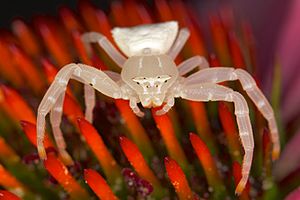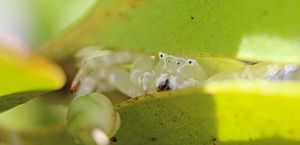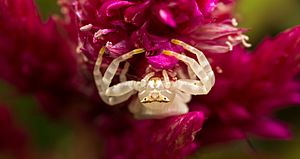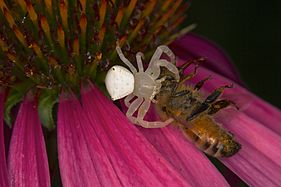White crab spider facts for kids
Quick facts for kids White crab spider |
|
|---|---|
 |
|
| Scientific classification |
The Thomisus spectabilis, also known as the white crab spider or Australian crab spider, is a small spider. You can find it in Australia and far east Asia.
Female spiders can grow up to 10 mm long. Males are smaller, about 6.2 mm. Including their legs, these spiders can be around 3 cm wide. They are usually white, but some can be yellow. Their legs and head look almost clear. The white crab spider is a hunter that waits for its prey. It often hides in flowers that are the same color as itself.
Female spiders lay their eggs in a folded leaf. The eggs are cream-colored and about 1 mm wide. A female can lay between 200 and 370 eggs. These spiders mainly eat insects. They like flowers with a certain shape, which helps them catch insects like butterflies and bees. The spider's color also reflects UV light. This creates a bright contrast that attracts bees.
You can often find Australian crab spiders in towns and cities. They live in Eastern Australia. Their favorite places are among white and yellow daisies.
Thomisus spectabilis spiders are venomous. They can be more aggressive than many other spiders. Their bites are not deadly to humans. However, they can cause mild pain in the area of the bite. These spiders do not spin webs. Instead, they chase and ambush their prey.
Contents
About the White Crab Spider
The white crab spider can change its color from yellow to white. This color change helps them hide from animals that might eat them. It also helps them sneak up on prey in daisies that are the same color. This way, they can either blend in or stand out to their prey. Their bright bodies reflect UV light. This attracts bees to the flowers where the spiders are hiding.
When the spider changes color, its head, legs, and body all become the same new color. Their legs can spread out up to 30 mm. They have small black eyes. These eyes are in a white band across their head, like a mask. The spider's body is shaped like a pentagon. It has two small bumps on it. Their strong legs are arranged like a crab's legs. They have fangs that can pinch. However, they cannot climb smooth surfaces because they lack special claw tufts.
Spider Family and Relatives
Australian crab spiders are very similar to other crab spiders around the world. These include crab spiders found in Europe, Alaska, or Canada. A common trait is that they do not build webs. Instead, they hide and ambush their prey using their front legs.
Crab spiders belong to a family called Thomisidae. The Australian crab spider is part of the Thomisus group within this family. Other spiders in the Thomisidae family can also change color. These include Misumena, Diaea, and Runcinia spiders. They are closely related to the Australian crab spider.
Spiders in the Thomisidae family have three main features. Their third and fourth legs are shorter and weaker than their first and second legs. Their side eyes are larger than their middle eyes. They also have a group of special hairs called setae.
Where They Live
Spider Homes
Australian crab spiders choose homes that help them catch food. They pick flowers and spots on flowers that create the best contrast. This contrast helps them attract prey. So, they must think about both the flower type and how many insects are around. They choose places that give them the best chance to catch food. T. spectabilis spiders like newer flowers. They are drawn to these flowers by their smell. You can find them mostly in warm, wet areas. Some also like to hang out on white clotheslines.
Where They Are Found
These spiders are found all over Australia. However, most of them live in Eastern Australia. They are mainly found in suburban areas. In Brisbane, for example, they are often seen in backyards, bushes, and gardens.
What They Eat
These spiders are predators. This means they hunt and eat other creatures. They mostly eat insects that are alive or have just died. Some of their meals include crickets, fruit flies, and pollinators like honey bees and butterflies. These spiders help control pests. They protect the flowers they live on from insect attacks. Eating these insects gives the adult female spider energy. This energy helps her produce a batch of eggs.
No Webs for These Spiders
Australian crab spiders do not build webs to catch food. They catch their prey by hiding and ambushing them. They use fallen leaves or green plants to hide. Their color helps them blend in easily. They can wait for up to two hours hidden under leaves to surprise their prey.
However, they can still make silk. They usually use silk to build small shelters. During the day, they rest in these shelters made of silk and leaves. At night, they come out. They wait on flowers to ambush their prey.
How They Behave
How They Catch Prey
These spiders do not use webs to catch food. Instead, they sit on flowers. They ambush insects that come to the flower. They use clues from their prey and the flowers to pick their hiding spots. Even though many spiders use camouflage, the Australian crab spider does not always hide perfectly from its prey. For example, honeybees can actually see the difference between the spiders and the flowers.
The Australian crab spider tricks its prey by using signals that normally attract insects to plants. Insects choose plants based on things like flower size, nectar, smell, color, or patterns. Honeybees are especially drawn to flowers with certain smells (meaning lots of nectar), colors, and symmetrical patterns. The Australian crab spider uses these same clues. This helps it get to the same flowers as the bees.
Liking Symmetrical Patterns
Honeybees like flowers with symmetrical patterns. This makes them pollinate those flowers. Both bees and Australian crab spiders are attracted to symmetry. This brings the hunter and its prey together on the same flowers. Over time, bees have learned to be careful around these spiders. Even though it's risky, bees still go to these flowers. This is because these flowers often have the most nectar and are the freshest. Honeybees prefer patterns that are symmetrical all around, like a circle. Crab spiders, however, are not as picky.
The white crab spider's liking for symmetry, along with smells, draws it to hide on flowers. It then ambushes honeybees when they arrive. The smells tell honeybees which flowers have the best rewards. These spiders have learned to be attracted to those same smells. They know bees will be there.
Using UV Light
Spiders can actively make honeybees come to the flower they are on. When the Australian crab spider is white, it can reflect UV light. This reflected UV light activates the bees' UV vision. It makes the spider stand out more against the flower. Bees are attracted to this bright contrast. They then fly to the flowers where the spiders are waiting to ambush them.
The amount of UV light reflected by these spiders can change. This change happens over time and between individual spiders. This variation is usually in the range of 300 to 400 nanometers. For example, in 2008, Thomisus spectabilis spiders reflected more UV light. They created a bigger color contrast with flowers than in 2009. This change helps spiders switch between being very noticeable and being less noticeable. This is important for attracting prey while staying safe from their own predators. Wasps and birds are common predators of these spiders. Both can see UV light. So, a white, bright UV-reflecting spider is more likely to be seen by predators.
The amount of UV light an individual spider reflects is not related to how much it has eaten. It's more about how much prey is available and the environment. It's also not related to the spider's size or shape. Instead, it's most strongly linked to whether predators are nearby. If there are no predators, the spider will reflect more UV light. This is because it always helps them attract more prey. This is different from other spider species, like Misumena vatia. Those spiders usually change their UV reflection to blend in with their surroundings.
Where They Sit on Flowers
The exact spot a spider chooses on a flower is also very important for catching prey. Honeybees are attracted to flowers partly based on how much nectar they have. They figure this out by looking at the center of the flower. To make sure they don't block this view, the spider needs to sit on the outer part of the flower. This allows them to create the color contrast that draws bees to the flower.
How Spider Size and Movement Affect Bees
Larger Thomisus spectabilis spiders are better at catching prey. Honeybees are more likely to land on flowers that have bigger spiders. So, larger Australian crab spiders don't need to use their UV-reflecting trick as much as smaller spiders to attract bees. For smaller spiders, using UV-reflectance leads to less hunting success than for larger spiders. Spider size is a bigger factor than UV-reflectance for attracting bees and successful hunting. Also, larger spiders tend to reflect more UV light. This suggests that size and UV-reflectance have developed together over time.
If Thomisus spectabilis spiders move before honeybees get close, the bees are much more likely to stay away. This is even more true if the spiders are waiting below the flower. If spiders stay still below the flower, they are 70% more likely to attract a bee. If they stay still above the flower, they are 50% more likely to attract a bee.
When crab spiders move, bees notice them. This makes bees decide if the risk of the spider is worth the reward of the nectar. Bees that are easily scared usually visit safe flowers, even if there isn't much nectar there. Other bees often have to choose riskier flowers. This is because those flowers usually have the most nectar. Flowers with hiding spiders can get damaged when bees are ambushed. So, these flowers have actually learned to produce more nectar. This helps them keep attracting bees despite the danger. Honeybees are good at finding the best flower patches. They use their amazing communication system to get the most nectar and avoid danger. Bees can tell their friends about good nectar spots. They can also warn each other about patches with hiding spiders.
Male and Female Spiders
Female T. spectabilis spiders are larger and stronger than males. So, it's the female spider that waits in flowers to ambush and catch insects. The male spider spends most of its time looking for females to mate with. They eat very little. Female spiders have bodies that reflect more light than male spiders. This reflection is very important for tricking and catching insects. Females are also in charge of building the egg sacs. They build them on curved leaves. They also guard the eggs and the young spiders.
How Spiders and Prey Change Together
The Australian crab spider eats different types of bees. The two main types are honeybees and Australian native bees. The spider's hunting methods work well on both. However, honeybees are especially easy to catch. This is because they haven't developed ways to avoid the Australian crab spider over time. When the spider creates color contrasts to trick bees, the honeybee immediately flies to the flower where the spider is waiting.
On the other hand, the Australian native bee has changed over time alongside the Australian crab spider. Because of this, they can tell the difference between flowers that have spiders and those that don't. For this to work, the bees must get very close to the flower. They will then land on a flower that doesn't have a spider. This means the crab spider catches many more honeybees than Australian native bees. It's also possible that Australian native bees have learned to smell crab spiders. This helps them avoid flowers where spiders are hiding.
The crab spider has also changed over time to better match the types of bees around them. Different pollinating insects are attracted to different levels of UV contrast. So, Thomisus spectabilis has learned to adjust the UV contrast they create with flowers. They do this by reflecting different amounts of UV light. Since honeybees can't tell the difference between flowers with and without spiders, Thomisus spectabilis will often create the UV contrast that attracts honeybees. They do this more than they create the UV contrast that attracts Australian native bees. The UV contrast is also affected by the spiders' predators in the area. If there are many predators nearby, the crab spider will reflect less UV light. This helps them attract less attention. They will do the opposite when there are very few predators.
The fact that Australian crab spiders don't always blend in affects which bees they can catch. The trick Thomisus spectabilis uses to attract prey actually makes them more noticeable to their prey. Bees react differently to being noticed. For example, Austroplebeia australis bees don't like being noticed. So, the spider's noticeable nature makes it less likely to catch those bees. In contrast, Trigona carbonaria bees don't change their behavior based on how noticeable spiders are. So, the Australian crab spider has a better chance of catching them.
Spider Bites
T. spectabilis spiders tend to bite more often than most other spiders. Their bites are venomous. They can cause mild but noticeable effects on humans. These effects can include pain in the bitten area, redness, dizziness, headaches, nausea, and swelling. However, these symptoms usually go away within one to two hours.
Images for kids
See also
 In Spanish: Thomisus spectabilis para niños
In Spanish: Thomisus spectabilis para niños







